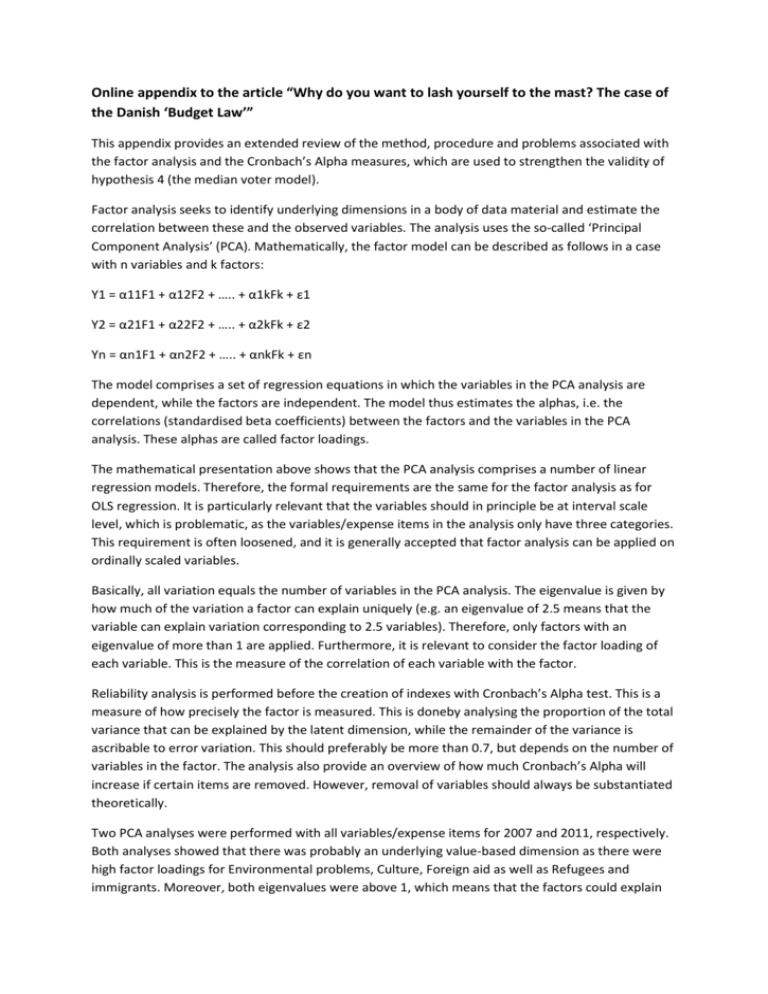Appendix
advertisement

Online appendix to the article “Why do you want to lash yourself to the mast? The case of the Danish ‘Budget Law’” This appendix provides an extended review of the method, procedure and problems associated with the factor analysis and the Cronbach’s Alpha measures, which are used to strengthen the validity of hypothesis 4 (the median voter model). Factor analysis seeks to identify underlying dimensions in a body of data material and estimate the correlation between these and the observed variables. The analysis uses the so-called ‘Principal Component Analysis’ (PCA). Mathematically, the factor model can be described as follows in a case with n variables and k factors: Y1 = α11F1 + α12F2 + ….. + α1kFk + ε1 Y2 = α21F1 + α22F2 + ….. + α2kFk + ε2 Yn = αn1F1 + αn2F2 + ….. + αnkFk + εn The model comprises a set of regression equations in which the variables in the PCA analysis are dependent, while the factors are independent. The model thus estimates the alphas, i.e. the correlations (standardised beta coefficients) between the factors and the variables in the PCA analysis. These alphas are called factor loadings. The mathematical presentation above shows that the PCA analysis comprises a number of linear regression models. Therefore, the formal requirements are the same for the factor analysis as for OLS regression. It is particularly relevant that the variables should in principle be at interval scale level, which is problematic, as the variables/expense items in the analysis only have three categories. This requirement is often loosened, and it is generally accepted that factor analysis can be applied on ordinally scaled variables. Basically, all variation equals the number of variables in the PCA analysis. The eigenvalue is given by how much of the variation a factor can explain uniquely (e.g. an eigenvalue of 2.5 means that the variable can explain variation corresponding to 2.5 variables). Therefore, only factors with an eigenvalue of more than 1 are applied. Furthermore, it is relevant to consider the factor loading of each variable. This is the measure of the correlation of each variable with the factor. Reliability analysis is performed before the creation of indexes with Cronbach’s Alpha test. This is a measure of how precisely the factor is measured. This is doneby analysing the proportion of the total variance that can be explained by the latent dimension, while the remainder of the variance is ascribable to error variation. This should preferably be more than 0.7, but depends on the number of variables in the factor. The analysis also provide an overview of how much Cronbach’s Alpha will increase if certain items are removed. However, removal of variables should always be substantiated theoretically. Two PCA analyses were performed with all variables/expense items for 2007 and 2011, respectively. Both analyses showed that there was probably an underlying value-based dimension as there were high factor loadings for Environmental problems, Culture, Foreign aid as well as Refugees and immigrants. Moreover, both eigenvalues were above 1, which means that the factors could explain more than the variance of just a single variable. The model for the two years with Cronbach’s Alpha is outlined below: Table 1: Factor analysis Expense Factor loadings valuebased policy 2007 Factor loadings valuebased policy 2011 Defence 0.089 -0.169 Healthcare 0.004 0.005 Education 0.454 -0.230 -0.322 0.290 Environment 0.567 -0.534 Culture 0.628 -0.639 Kindergartens and nurseries 0.206 -0.044 Unemployment benefits 0.132 -0.108 Welfare benefits 0.289 -0.323 Foreign aid 0.796 -0.792 Refugees and immigrants 0.753 -0.770 Home care -0.074 0.124 Motorways and bridges -0.035 0.039 Police -0.133 0.170 Old age pensions N Eigenvalue % of variation explained 3595 770 3.73 2.09 26.66 14.94 Table 1 confirms the idea that some of the variation in the expense items is attributable to a valuebased dimension. This is confirmed by eigenvalues, which show that the value-based dimension can explain what corresponds to the variation for 3.73 variables in 2007 and 2.09 variables in 2011 (corresponding to 26.66 per cent and 14.94 per cent, respectively, of the variation). It can therefore be argued that the variables Environmental problems, Culture, Foreign aid as well as Refugees and immigrants should be removed from the aggregate expense policy preference index (EPPI) because they could reflect value-based and not expense preferences. Also, the reliability test in Table 2 (measured by Cronbach’s Alpha1) reveals that the reliability of the EPPI index is increased if the variables Defence and Motorways and bridges are also removed. 1 The Cronbach’s Alpha value shows the proportion of the total variance caused by an underlying latent dimension, and the measure provides an expression of the ‘true’ variance as a proportion of the total variance, while the remainder is probably ascribable to error variation. Table 2: Cronbach’s Alpha Cronbach’s Alpha for indices where the following value-based variables have been removed: EPPI 2007 EPPI 2011 Environmental problems Culture Foreign aid Refugees and immigrants 0.564 0.571 0.645 0.626 0.614 0.618 Environmental problems Culture Foreign aid Refugees and immigrants Defence Environmental problems Culture Foreign aid Refugees and immigrants Motorways and bridges However, the Motorways and bridges variable is included in the index below, as there is no theoretical explanation to justify its removal. Index showing the shift in preference Based on the analysis outlined above, we can create three indexes reflecting the voters’ expense preferences, cf. Table 3. Transfers in connection with unemployment have been included in the calculations above though they are not comprised by the spending ceilings in the Budget Law. The reason is that the Budget Law may also be considered to apply to these, as it requires the minister of finance to present proposals that meet spending overruns of a permanent nature regarding the transfer payments (Ministry of Finance 2012b: 8). The first index comprises all variables. The second index excludes the following variables: Environmental problems, Culture, Foreign aid as well as Refugees and immigrants. The third index excludes these four value-based variables as well as Defence. Thus, it is tested whether the voters prefer significantly lower public expenditure in 2011 than in 2007 via three reflexive aggregated expense policy preference indexes (EPPI). These have been coded on a 0-100 scale, with a value of 50 corresponding to a total PFI value of 0, i.e. the same number of respondents find that the expense is too high and too low. Table 3: Difference between the expense preference indices Expense preference index EPPI 2007 EPPI 2011 Sig. EPPI diff. N 2007 N 2011 Expense preference index, all expense items 63.52 (.220) 58.83 (.427) (.000)*** 4.66 3595 770 Expense preference index, without value-based expense items 67.41 (.204) 63.82 (.453) (.000)*** 3.59 3642 815 Expense preference index 2007, without value-based expenses incl. defence 71.37 (.227) 67.98 (.499) (.000)*** 3.39 3671 818 Note: Standard errors in brackets, *significant at 0.1 level, **significant at 0.05 level, ***significant at 0.01 level. As the table shows, all three indexes have declined significantly (a decrease between 4.66 and 3.39 on a 0-100 scale). Moreover, it appears that the shift in voters’ preferences – as expected – will be slightly less pronounced in step with the number of value-based questions removed from the index. However it can be argued that removing the variables is a highly conservative test of the hypothesis. First, value political changes still make spending cuts easier on the expense items that are least preferred by voters. Second, research on the psychological effect of economic recessions has shown that people tend to distinguish themselves from what they view as ‘foreign’. White persons who view pictures of bi-racial people are more likely to categorize the faces as black when given cues that signal economic recession. They are more likely to label the faces as white when given cues that signal economic prosperity (Rodeheffer et al. 2012). Therefore the above effects are likely to be a result of the economic crisis as well and not only a representation of shifts in value political voter preferences. All in all, the adoption of the Budget Law cannot be viewed as an initiative intended to appeal to voters, as the parties according to the median voter model should raise spending to win votes. However, the adoption of the Budget Law has most likely been made much easier by the voters preferring/accepting lower public expenditure after the crisis. This dynamics is often confirmed empirically because the voters’ expectations to public consumption follow the economic cycle, implying that it is much easier to pursue a tight expenditure policy in periods of economic downturn because the voters’ attitude changed due to the crisis. Thus, the crisis opens a window of opportunity for taking the Budget Law through Parliament. Overall, the above results strengthen the analysis of hypothesis 3. The significant shifts in voter preferences are found even when value political variables are removed from the EPPI index. The results are robust.






